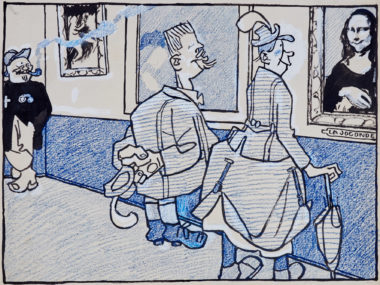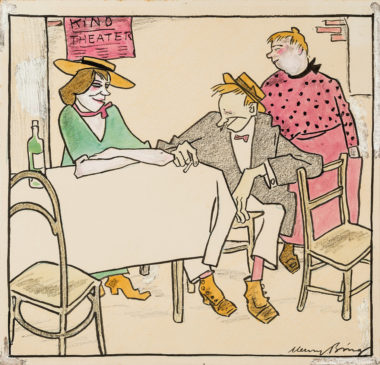Bing, Henry
Available Artworks
Sold Artworks
Biography
Henry Bing
1888 – Paris – 1965
The French painter, draughtsman and lithographer Henry Bing was only seventeen when he joined the staff of the German illustrated magazines Jugend and Simplicissimus. Over the next ten years some nine hundred of his drawings would be published. The broad coverage offered by both magazines was to make Bing something of a household name. It is therefore surprising that no portrait photographs or documentation relating to his artistic background have survived.
Records show that by 1905 Bing was living in Munich and a regular guest at the Cafe Stefanie in Munich’s thriving bohemian quarter, where he mixed with many of the leading artistic personalities of the time. The cafe was a popular meeting-place for avant-garde writers and artists. Bing received an income from royalties generated by the publication of his caricatures in Jugend and Simplicissimus and supplemented it by selling the original drawings. In 1912, two leading Munich art dealers – Franz Josef Brakl and Hans Goltz – began to market his work. When war broke out he was interned as an enemy alien. This marked an abrupt end to his artistic career. He was released when the war ended and in 1920 returned to Paris. Here he forged a new career as an art dealer specializing in modernism, selling work by Henri (Le Douanier) Rousseau, Robert Delaunay, Amedeo Modigliani and Chaim Soutine.
Bing’s early drawings for Jugend and Simplicissimus draw heavily on the style and subject matter of his older colleagues, particularly Rudolf Wilke. However Bing was quick to develop his own individual style and thematic interests. He depicted the outcasts, misfits and underdogs of society, among them tramps, beggars, day labourers and factory workers, maidservants and market vendors. But he also depicted artists and writers in coffeehouse scenes, women of the demi-monde and vaudeville performers. His drawings have a powerful linearity and are often reduced to a few essential elements rapidly sketched in watercolour and coloured crayon. His scenes are sparsely populated and facial features are radically simplified in order to reveal underlying character traits. Bing was a compassionate draughtsman, never out to offend – despite the satirical content of his images, which the publishers of both magazines emphasized by subtitling them with biting captions. Rather, Bing’s intention was to plead empathy and understanding for all those whom a cruel fate had forced to the margins of society.
PDF Download
